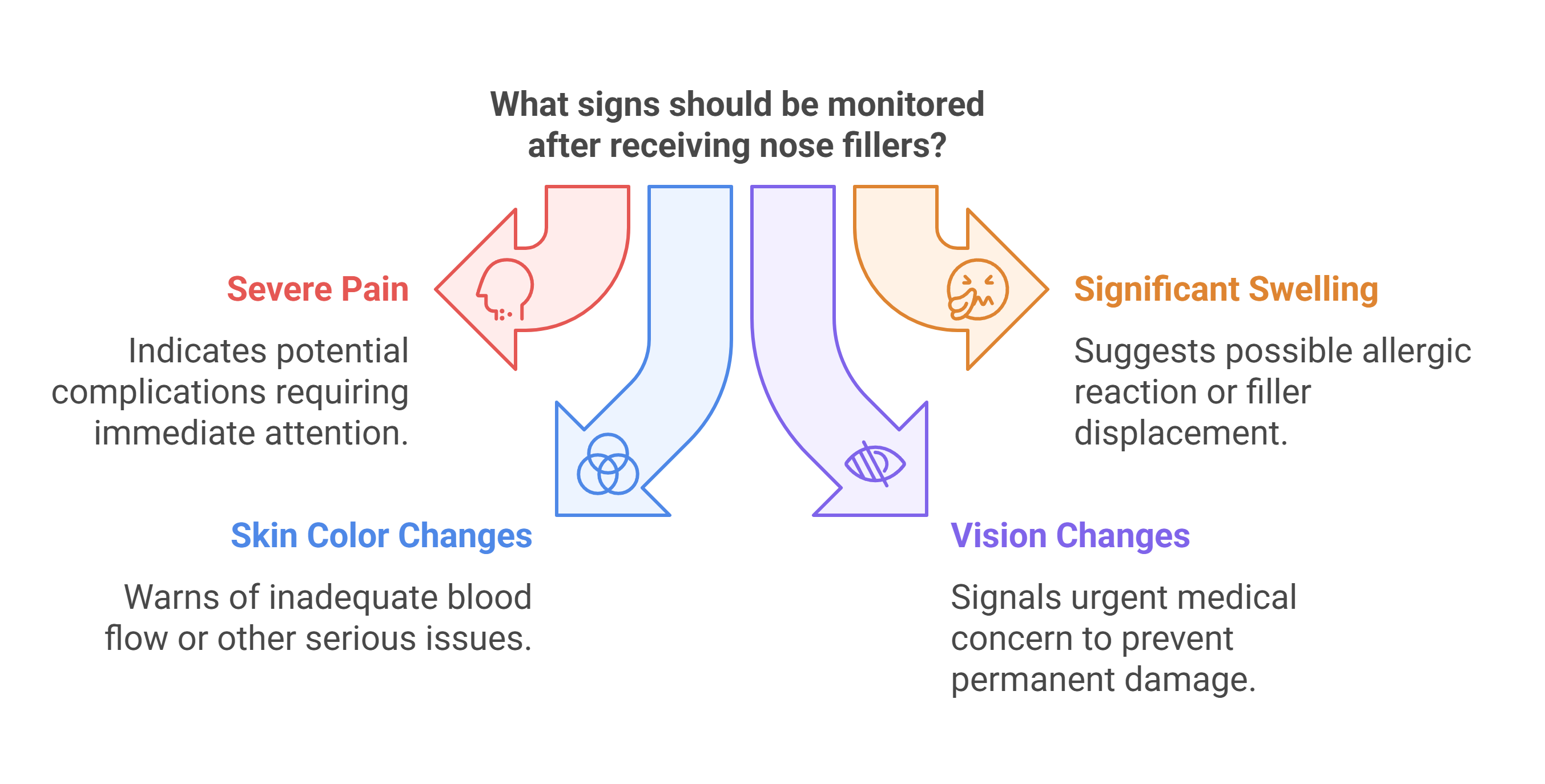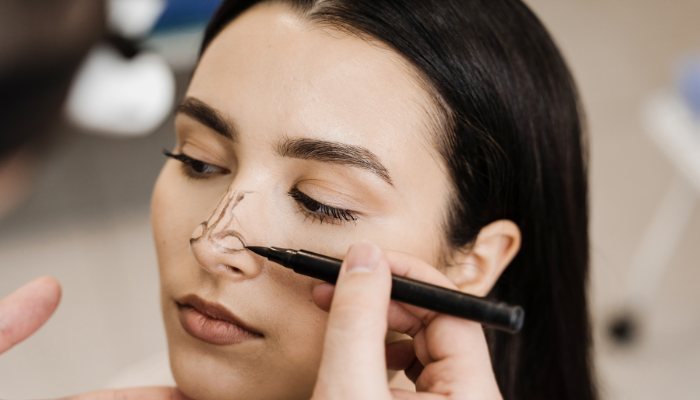Considering nose fillers? It’s essential to understand the possible complications that can arise from this popular cosmetic treatment. While many people achieve satisfying results, there are risks involved that you should be aware of.
This article will walk you through the common complications associated with nose fillers, from minor side effects to serious issues, and how to manage them effectively.
Key Takeaways
- Nose filler complications can range from mild side effects like swelling and bruising to serious risks such as infection and skin necrosis.
- Choosing a qualified practitioner is crucial to minimise complications and achieve the desired results.
- Understanding the potential for overfilling, lumps, and filler migration can help you manage unsatisfactory outcomes.
- Following aftercare instructions is vital for recovery and can help prevent complications post-treatment.
- If complications do occur, options like dissolving the filler or consulting a specialist are available to address issues.
Understanding Nose Filler Complications
Nose fillers, or liquid rhinoplasty, have become a popular way to reshape the nose without surgery. However, like any cosmetic procedure, it’s important to be aware of potential complications. It’s not all sunshine and rainbows, you know?
Let’s have a look at what can go wrong, so you’re fully informed.
Common Side Effects
Alright, so straight after getting nose fillers, expect a bit of the usual stuff. We’re talking swelling, maybe some bruising, and a bit of redness around the injection sites. It’s pretty normal, and usually calms down in a few days.
Don’t stress too much if you look like you’ve had a mild punch to the nose – it’s all part of the process. Most people find that over-the-counter pain relief is enough to manage any discomfort. If it doesn’t, you should contact your practitioner.
Long-Term Risks
While most side effects are temporary, there are some longer-term risks to consider. These are less common, but it’s good to be aware of them.
We’re talking about things like filler migration (where the filler moves from where it was injected), nodule formation (small lumps forming under the skin), and, in very rare cases, vascular compromise (where the filler affects the blood supply). It’s important to choose an experienced practitioner to minimise these risks.
Factors Influencing Complications
Loads of things can affect how likely you are to get complications. The skill of the person doing the injecting is a big one – you want someone who knows their stuff.
The type of filler used also matters, as some are more prone to problems than others. And, of course, your own body and how it reacts to the filler plays a part. It’s a bit of a lottery, but doing your homework can seriously improve your odds.
It’s worth remembering that nose fillers aren’t a permanent fix. They last for a while, but eventually, your body will break down the filler. This means you’ll need top-ups to maintain the effect, and each time you get them, there’s a small risk of something going wrong. So, it’s not a one-off decision, but something you need to think about long-term.
Immediate Reactions After Treatment
Alright, so you’ve just had your nose filler done. What can you expect straight away? It’s good to be prepared, so let’s run through the common immediate reactions.
Swelling and Bruising
Swelling and bruising are pretty standard after nose filler. It’s your body’s natural response to the injection. The amount varies from person to person; some people barely notice it, while others might have a bit more obvious swelling. Don’t stress too much, it usually calms down within a few days to a week.
Pain and Discomfort
Most people describe the feeling after nose filler as more of a discomfort than outright pain. You might feel a bit tender or sensitive to the touch. Often, the filler itself contains a local anaesthetic, which helps to minimise any pain during the procedure and immediately afterwards.
If you do experience any discomfort, over-the-counter pain relief like paracetamol should do the trick. Just avoid anything that thins the blood, like ibuprofen or aspirin, as this can increase bruising.
Redness and Sensitivity
Redness at the injection sites is another common immediate reaction. Your skin might also feel a bit more sensitive than usual. This is usually temporary and fades within a few hours. It’s best to avoid touching or applying any pressure to the area to allow the redness to subside naturally.
Also, steer clear of harsh skincare products or makeup on or around your nose for at least 24 hours to minimise irritation.
It’s important to remember that everyone’s experience is different. If you’re concerned about any of these reactions, don’t hesitate to contact your practitioner. They’re there to support you through the healing process and address any worries you might have.
Serious Complications to Watch For

Okay, so we’ve talked about the usual swelling and maybe a bit of bruising. But what about the stuff that’s actually worrying? Nose fillers, like any procedure, carry risks, and it’s important to know what to look out for.
Early detection and quick action are key to managing these complications effectively. Don’t panic, but do be aware.
Infection Risks
Infections after nose filler are rare, but they can happen. It’s usually down to bacteria getting into the injection site. Keep an eye out for increasing redness, swelling that gets worse instead of better, pain, heat, or even pus. If you spot any of these, don’t wait – get in touch with your practitioner ASAP.
They might need to prescribe antibiotics to clear things up. Prevention is better than cure, so make sure your clinic is super clean and uses sterile equipment.
Vascular Compromise
Vascular compromise is a fancy way of saying that the filler has blocked or compressed a blood vessel. This is a serious one because it can lead to tissue damage. It’s not common, but it’s something you need to be aware of.
Signs include:
- Sudden, severe pain that’s way worse than what you’d expect.
- Skin that turns pale or mottled.
- Blisters or ulcers forming on the skin.
If you see any of these, it’s an emergency. You need to get to a doctor or your practitioner immediately. They might need to dissolve the filler to restore blood flow.
Skin Necrosis
Skin necrosis is what happens when the skin doesn’t get enough blood and starts to die. It’s a direct result of vascular compromise. It’s scary, but treatable if caught early. Look for:
- Skin that turns black or dark blue.
- A hard, scab-like area forming.
- Loss of sensation in the affected area.
Again, this is an emergency. The sooner you get treatment, the better the outcome. Doctors can use various methods to try and restore blood flow and prevent further damage.
It’s easy to get freaked out by all this, but remember, serious complications are rare. The best thing you can do is choose a skilled practitioner, follow their aftercare advice to the letter, and be vigilant about watching for any unusual signs. If in doubt, always get it checked out.
Managing Unsatisfactory Results
Okay, so you’ve had nose filler, and you’re not exactly thrilled with the outcome. It happens! Don’t panic. There are definitely things we can do to sort it out. It’s all about understanding what went wrong and what your options are.
Communication with your practitioner is key here. They need to know exactly what you’re unhappy with so you can work together on a solution.
Overfilled Appearance
Sometimes, the filler can make the nose look a bit too big or unnatural. It’s a common concern, especially right after the procedure when there might be some swelling. The good news is that hyaluronic acid fillers can be dissolved. If it’s a case of too much filler, your practitioner can use hyaluronidase to break it down.
It’s usually a pretty quick and straightforward process, and you should see results within a few days. It’s worth noting that sometimes, it’s not necessarily too much filler, but rather the placement that needs adjusting.
Lumps and Bumps
Lumps and bumps can appear if the filler wasn’t injected smoothly or if it’s settled unevenly. Small lumps might disappear on their own after a couple of weeks, as the filler integrates with the tissue. However, if they’re still there, or if they’re quite noticeable, there are a few things you can try:
- Massage: Gentle massage can help to smooth out the filler.
- Hyaluronidase: Small amounts can be injected directly into the lumps to dissolve them.
- Ultrasound: Some practitioners use ultrasound to help break down the filler.
Migration of Filler
Filler migration is when the filler moves from the injection site to another area. It’s not super common, but it can happen. If you notice the filler has moved, it’s important to see your practitioner.
They can assess the situation and decide on the best course of action. Usually, it involves dissolving the migrated filler with hyaluronidase. It’s also a good idea to discuss why it might have happened in the first place, so you can avoid it in the future.
It’s important to remember that nose filler results aren’t permanent. They typically last between 12 and 18 months. If you’re really unhappy with the results, you can always wait for the filler to dissolve naturally. However, if you want a quicker fix, dissolving the filler is usually the best option.
Preventing Nose Filler Complications
Look, nobody wants things to go wrong, right? When it comes to nose fillers, a little bit of planning and caution can go a long way. It’s all about minimising the risks and making sure you’re happy with the outcome. Let’s break down how to keep things smooth.
Choosing a Qualified Practitioner
This is the most important thing, honestly. Don’t just go for the cheapest option or the place with the flashiest ads. You need someone who knows their stuff. I’m talking about a doctor, a dermatologist, or a plastic surgeon – someone with serious training and a solid reputation.
Check their credentials, read reviews, and don’t be afraid to ask loads of questions. If they can’t answer them clearly and confidently, that’s a red flag.
Setting Realistic Expectations
Nose fillers can do some pretty cool things, but they’re not magic. They can smooth out bumps, make your nose look a bit straighter, or add some definition. But they can’t give you a completely new nose.
Have a proper chat with your practitioner about what’s achievable. It’s better to be pleasantly surprised than bitterly disappointed. Plus, if you go in expecting too much, you might end up pushing for more filler than you actually need, which can lead to problems.
Following Aftercare Instructions
So, you’ve had your fillers, and you’re thrilled with the results. Great! But the job’s not done yet. Aftercare is key to preventing complications. Your practitioner will give you a list of things to do (and not do) in the days and weeks following your treatment. This might include:
- Avoiding touching or putting pressure on your nose.
- Sleeping on your back.
- Skipping strenuous exercise for a few days.
- Avoiding extreme temperatures (like saunas or sunbeds).
Listen to your practitioner, and follow their advice to the letter. It might seem like a hassle, but it’s worth it to avoid problems down the line. If something doesn’t feel right, don’t hesitate to get in touch with them. Early intervention is always better than waiting for things to get worse.
Corrective Measures for Complications
There are several ways to address complications and get you back on track. It’s all about understanding your options and working with a skilled practitioner to find the best solution for your specific situation.
Dissolving the Filler
If the issue is overfilling, asymmetry, or even early signs of vascular compromise, dissolving the filler is often the first and best option. Hyaluronidase is an enzyme that breaks down hyaluronic acid fillers.
The procedure involves injecting hyaluronidase into the treated area, which then dissolves the filler over a few days. It’s relatively quick, and while there might be some minor swelling or bruising, it’s generally well-tolerated. The number of hyaluronidase injections needed depends on the amount of filler that needs to be dissolved.
Surgical Interventions
In rare cases, where complications are severe or involve permanent damage, surgical intervention might be necessary. This could include:
- Filler removal: If the filler has migrated or caused significant distortion, surgical removal might be the most effective solution.
- Skin grafting: For skin necrosis, a skin graft can help restore the damaged area.
- Corrective rhinoplasty: In cases of severe structural damage, a full rhinoplasty might be needed to rebuild the nose.
Consulting a Specialist
The most important step is to consult with a qualified and experienced specialist. This could be a dermatologist, plastic surgeon, or another medical professional with expertise in nose filler complications. They can assess your situation, determine the cause of the problem, and recommend the most appropriate course of action.
Don’t hesitate to seek a second opinion if you’re not comfortable with the initial assessment.
Remember, addressing complications early is key to achieving the best possible outcome. Don’t delay seeking professional help if you notice any concerning signs or symptoms after your nose filler treatment.
The Importance of Aftercare
The journey doesn’t end the moment you leave the clinic. Proper aftercare is vital for ensuring the best possible results and minimising the risk of complications. Think of it as investing in the longevity and success of your treatment. It’s not just about aesthetics; it’s about your health and well-being.
Post-Treatment Guidelines
Following your practitioner’s aftercare instructions is really important. These guidelines are designed to help your nose heal properly and allow the filler to settle. Here’s what you should expect:
- Avoid touching or applying pressure: For the first few hours, try not to touch your nose too much. The filler is still settling, and you don’t want to move it around.
- Skip the makeup: Avoid applying makeup on or around your nose for at least 24 hours post-treatment. You want to minimise the risk of irritation or infection.
- Stay out of the sun: Avoid direct sunlight and sun beds for about a week. Your skin might be a bit sensitive after the procedure. Always use a broad-spectrum sunscreen with an SPF of 30 or higher when outdoors, as the treated area may be more sensitive to ultraviolet (UV) radiation.
- No saunas: It’s best to stay away from saunas for about a week. The heat can increase swelling and delay healing.
- Avoid blood thinners: Things like aspirin, ibuprofen, and certain supplements can thin your blood and increase the risk of bruising. Try to avoid these for a few days after your procedure.
- Easy on the glasses: If you wear glasses or sunglasses, try to minimise their use for about two weeks post-treatment. They can put pressure on the nose and affect the results.
Signs of Complications
Being aware of potential complications is key to addressing them quickly. While most side effects are mild and temporary, it’s important to know what to look out for. Keep an eye out for:
- Increased pain or swelling: A little discomfort is normal, but escalating pain or significant swelling isn’t.
- Redness or warmth: These could be signs of an infection.
- Changes in skin colour: Paleness, blueness, or darkening of the skin could indicate vascular compromise.
- Unusual discharge: Any discharge from the injection site should be reported immediately.
When to Seek Help
Don’t hesitate to contact your practitioner if you experience any concerning symptoms. Early intervention can prevent minor issues from becoming major problems. It’s always better to be safe than sorry. If you can’t reach your practitioner, seek medical attention from another qualified professional. Your health is the priority.
Remember, aftercare is a partnership between you and your practitioner. By following their advice and staying vigilant, you can help ensure a smooth recovery and enjoy your enhanced appearance with confidence.
Conclusion
While nose fillers can offer a quick and non-invasive way to enhance your appearance, it’s important to be aware of the potential complications that can arise. From minor issues like swelling and bruising to more serious concerns such as infection or migration of the filler, being informed is key.
If you do experience any complications, don’t hesitate to reach out to your practitioner for guidance. Remember, a practitioner with an aesthetic precision can help you navigate these challenges effectively. With the right care and attention, you can achieve the results you desire while minimising risks.
Frequently Asked Questions
What are the common side effects of nose fillers?
After getting nose fillers, some common side effects include swelling, bruising, and redness. These usually go away within a few days.
Can nose fillers cause serious problems?
Yes, although rare, nose fillers can lead to serious issues like infections or skin damage. It’s important to choose a skilled practitioner to reduce these risks.
How long do the effects of nose fillers last?
Nose fillers typically last between 6 to 12 months, depending on the type of filler used and individual factors.
What should I do if I am unhappy with the results?
If you’re not happy with your nose fillers, consult your practitioner. They can discuss options like dissolving the filler or making adjustments.
How can I prevent complications from nose fillers?
To prevent complications, choose a qualified practitioner, set realistic expectations, and follow all aftercare instructions.
What aftercare is needed after getting nose fillers?
After getting nose fillers, avoid touching the area, stay away from high temperatures, and follow any specific instructions from your practitioner.






